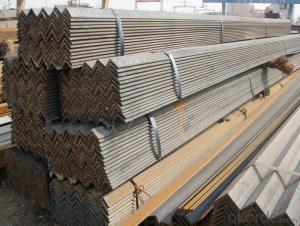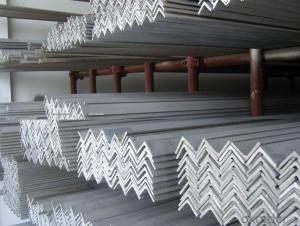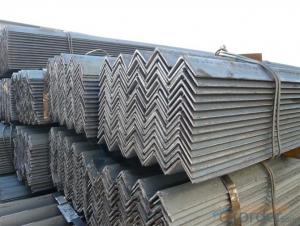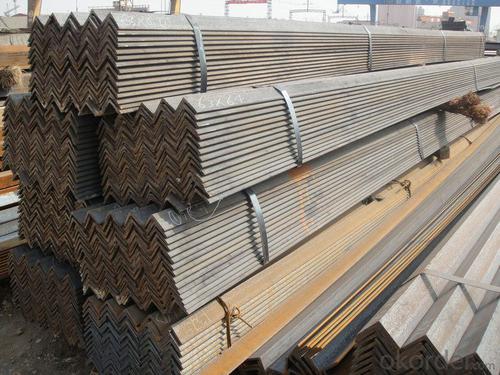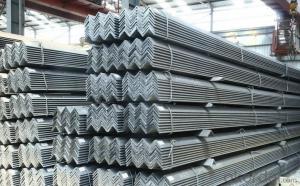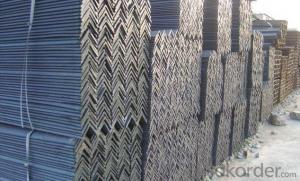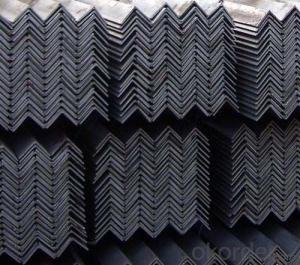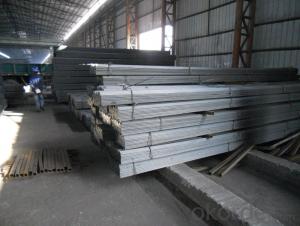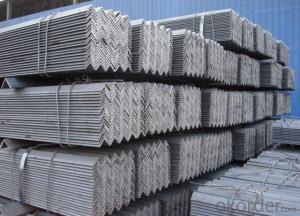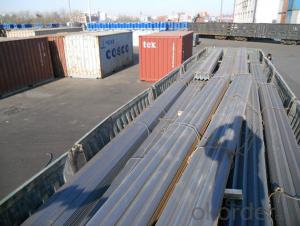Steel Equal Angle with Good Quality 200mm*200mm
- Loading Port:
- Tianjin
- Payment Terms:
- TT OR LC
- Min Order Qty:
- 100 m.t.
- Supply Capability:
- 15000 m.t./month
OKorder Service Pledge
OKorder Financial Service
You Might Also Like
Specification
Specifications of Steel Equal Angle with Good Quality 200mm*200mm
1. Invoicing on theoretical weight or actual weight as customer request
2. Length: 6m and 12m
3. Sizes:
| Size(mm) | Mass(kg/m) | Size(mm) | Mass(kg/m) |
| 200*200*14 | 42.894 | 200*200*20 | 60.056 |
| 200*200*16 | 48.894 | 200*200*24 | 71.168 |
Packaging & Delivery of Steel Equal Angle with Good Quality 200mm*200mm:
1. Packing: it is nude packed in bundles by steel wire rod
2. Bundle weight: not more than 3.5MT for bulk vessel; less than 3 MT for container load
3. Marks:
-Color marking: There will be color marking on both end of the bundle for the cargo delivered by bulk vessel. That makes it easily to distinguish at the destination port.
-Tag mark: there will be tag mark tied up on the bundles. The information usually including supplier logo and name, product name, made in China, shipping marks and other information request by the customer.
If loading by container the marking is not needed, but we will prepare it as customer request.
FAQ:
Q1: Why buy Materials & Equipment from OKorder.com?
A1: All products offered byOKorder.com are carefully selected from China's most reliable manufacturing enterprises. Through its ISO certifications, OKorder.com adheres to the highest standards and a commitment to supply chain safety and customer satisfaction.
Q2: How do we guarantee the quality of our products?
A2: We have established an advanced quality management system which conducts strict quality tests at every step, from raw materials to the final product. At the same time, we provide extensive follow-up service assurances as required.
Q3: How soon can we receive the product after purchase?
A3: Within three days of placing an order, we will begin production. The specific shipping date is dependent upon international and government factors, but is typically 1 to 2 months.
Q4: How many tons per bundle?
A4: Around 2-3tons
Q5: How many tons can be loaded into one 20ft container?
A5: Around 23—25tons(6m)
Q6: How many tons can be loaded into one 40ft container?
A6: Around 23—25tons(12m)
Q7: How to avoid the rust after deliver the goods to the loading port?
A7: We will keep the goods at the port covered with water-proof material
Production flow of Steel Equal Angle with Good Quality 200mm*200mm:
Material prepare (billet) —heat up—rough rolling—precision rolling—cooling—packing—storage and transportation
Images of Steel Equal Angle with Good Quality 200mm*200mm:
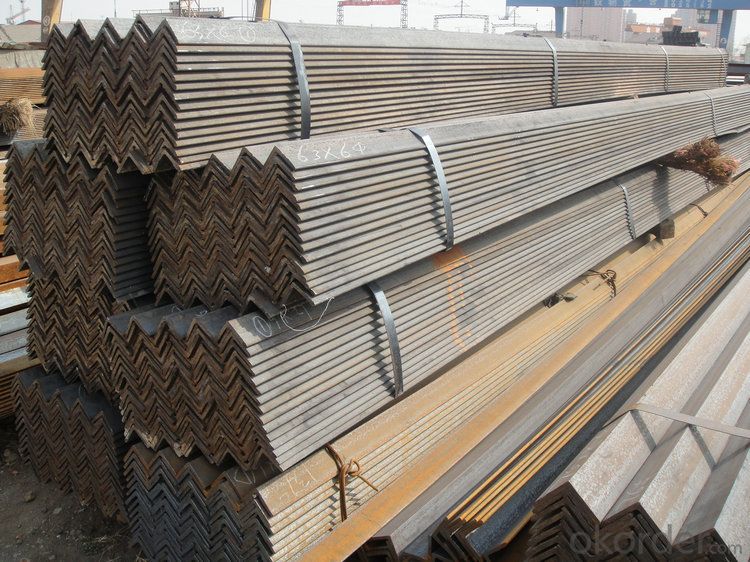
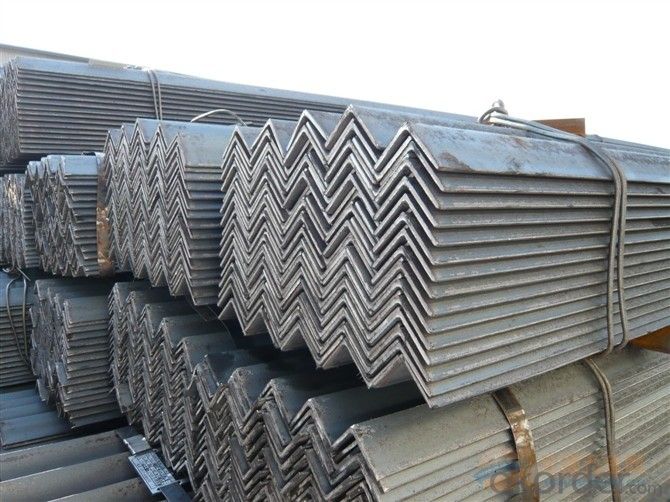
- Q: Can steel angles be used for acoustic isolation or noise barriers?
- No, steel angles are not typically used for acoustic isolation or noise barriers as they do not possess the necessary properties to effectively block or absorb sound. Other materials such as acoustic panels or specialized barriers are more commonly used for this purpose.
- Q: Can steel angles be used for structural applications?
- Yes, steel angles can be used for structural applications. Steel angles are commonly used in construction and engineering projects due to their strength, durability, and versatility. They are particularly useful in providing structural support and stability, as they can be easily welded, bolted, or otherwise connected to other steel components. Steel angles are often utilized in the construction of frames, supports, braces, and reinforcements. Additionally, their shape and design allow for efficient load-bearing capabilities, making them suitable for various structural applications such as bridges, buildings, towers, and industrial structures. Overall, steel angles are a reliable and cost-effective choice for structural applications.
- Q: How do you protect steel angles from moisture?
- Steel angles can be protected from moisture by applying a suitable coating or paint that acts as a barrier against moisture. Additionally, regular inspection and maintenance, including the removal of any rust or corrosion, can help prevent moisture damage.
- Q: What are the different types of connections used for steel angles?
- There are several types of connections used for steel angles, including bolted connections, welded connections, and riveted connections.
- Q: What are the different methods for painting steel angles?
- There are several different methods for painting steel angles, depending on the desired result and the specific conditions of the project. Some common methods include: 1. Brush application: This is the most traditional and commonly used method for painting steel angles. It involves using a paintbrush to apply the paint directly onto the surface of the steel angle. This method allows for more control and precision in painting, especially for smaller or intricate areas. 2. Spray application: Spray painting is a popular method for large-scale or industrial projects. It involves using a paint sprayer to evenly distribute the paint onto the steel angle. This method is faster and more efficient than brush application, and it can provide a smooth, uniform finish. 3. Powder coating: Powder coating is a method that involves applying a dry powder to the steel angle, which is then cured under heat to create a durable and attractive finish. This method is known for its resistance to chipping, scratching, and fading, making it ideal for outdoor applications or areas with high traffic. 4. Electrostatic painting: Electrostatic painting is a technique that uses an electric charge to attract the paint particles to the steel angle. This method ensures even coverage and reduced overspray, resulting in a smooth and durable finish. Electrostatic painting is often used for large or complex surfaces, as it can provide superior adhesion and coverage. 5. Galvanizing: Galvanizing is a unique method for protecting steel angles from corrosion. It involves coating the steel angle with a layer of zinc through a hot-dip or electroplating process. Galvanized steel angles are highly durable and resistant to rust, making them suitable for outdoor or high-moisture environments. While galvanizing does not provide a specific color or aesthetic finish, the zinc coating can be painted over if desired. When selecting a painting method for steel angles, it is essential to consider factors such as the desired appearance, durability, environmental conditions, and project specifications. Consulting with a professional or following the manufacturer's recommendations can help ensure the best method is chosen for each unique project.
- Q: What are the common corrosion protection methods for steel angles?
- Steel angles can be protected from corrosion in multiple ways. The objective of these methods is to hinder or reduce the corrosion process caused by exposure to moisture or certain chemicals. Here are some widely used techniques for corrosion protection in steel angles: 1. Galvanization: This popular method involves coating the steel angle with a layer of zinc. The zinc acts as a sacrificial anode, corroding instead of the steel when exposed to moisture or chemicals. Galvanization provides excellent corrosion protection, significantly extending the lifespan of steel angles. 2. Painting: A layer of paint can serve as a barrier between the steel angle and its surroundings, preventing moisture and chemicals from reaching the surface. It is crucial to select the appropriate paint type designed specifically for corrosion protection and ensure proper surface preparation before painting. 3. Powder coating: This technique entails applying a dry powder to the steel angle, which is then heated and cured to form a durable and protective coating. Powder coating delivers excellent corrosion resistance and is commonly used in outdoor settings. 4. Epoxy coating: Epoxy coatings are frequently employed in corrosive environments like chemical plants or marine applications. These coatings exhibit high chemical resistance and create a protective barrier against corrosion. 5. Cathodic protection: This method involves utilizing the steel angle as the cathode in a galvanic cell, with a sacrificial anode connected to it. This arrangement initiates an electrochemical reaction that prevents corrosion. Cathodic protection finds application in structures such as underground pipelines or offshore platforms. It is essential to consider various factors such as the specific environment, expected service life, and budget while selecting a corrosion protection method. Seeking advice from corrosion protection specialists or engineers can assist in determining the most suitable approach for a particular application.
- Q: What are the common surface treatments for steel angles?
- There are several common surface treatments for steel angles, depending on the desired application and level of corrosion resistance required. Some of the most common surface treatments include: 1. Hot-dip galvanizing: This process involves immersing the steel angles in a bath of molten zinc, which forms a protective layer on the surface. Hot-dip galvanizing provides excellent corrosion resistance and is commonly used in outdoor applications. 2. Powder coating: Powder coating involves applying a dry powder to the surface of the steel angles, which is then cured under heat to form a protective and decorative coating. Powder coating is highly durable and provides good corrosion resistance, making it suitable for both indoor and outdoor applications. 3. Paint: Painting steel angles is a cost-effective and versatile surface treatment option. The steel angles are typically primed with a rust-inhibiting primer and then painted with a suitable topcoat. Paint provides a decorative finish and some level of corrosion resistance, although it may not be as long-lasting as other treatments. 4. Electroplating: Electroplating is a process where a thin layer of metal, such as zinc or chrome, is deposited onto the surface of the steel angles using an electric current. This treatment provides both corrosion resistance and aesthetic appeal, making it suitable for various applications. 5. Anodizing: Anodizing is typically used for aluminum, but it can also be applied to steel angles. This process involves creating an oxide layer on the surface of the metal, which provides corrosion resistance and improved durability. Anodizing can also provide a decorative finish and is commonly used in architectural applications. It's important to note that the choice of surface treatment for steel angles depends on factors such as the intended use, budget, and environmental conditions. Consulting with professionals or experts in the field can help determine the most suitable surface treatment for a specific application.
- Q: What is the typical lead time for steel angle orders?
- The typical lead time for steel angle orders can vary depending on multiple factors such as the supplier, quantity, customization requirements, and current market conditions. However, in general, lead times for steel angle orders tend to range between 2 to 4 weeks. This allows for the processing of the order, manufacturing or sourcing the steel angles, and transportation to the desired location. It is important to note that lead times can be influenced by factors such as availability of raw materials, production capacity, and supplier's workload. Therefore, it is advisable to contact the specific supplier or manufacturer for accurate and up-to-date lead time information.
- Q: What are the common methods of surface cleaning for steel angles?
- The common methods of surface cleaning for steel angles include abrasive blasting, chemical cleaning, and mechanical cleaning. Abrasive blasting involves using high-pressure air or water to propel abrasive materials onto the surface of the steel angle, effectively removing rust, scale, and other contaminants. Chemical cleaning involves applying specialized cleaning agents or solvents to dissolve and remove dirt, grease, or oil from the surface. Mechanical cleaning involves physically scrubbing the surface using wire brushes or abrasive pads to remove any visible debris or contaminants.
Send your message to us
Steel Equal Angle with Good Quality 200mm*200mm
- Loading Port:
- Tianjin
- Payment Terms:
- TT OR LC
- Min Order Qty:
- 100 m.t.
- Supply Capability:
- 15000 m.t./month
OKorder Service Pledge
OKorder Financial Service
Similar products
Hot products
Hot Searches
Related keywords
